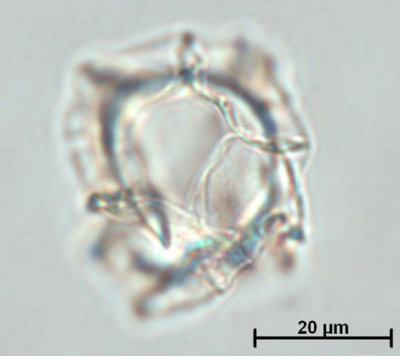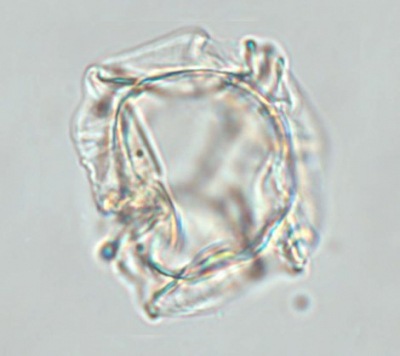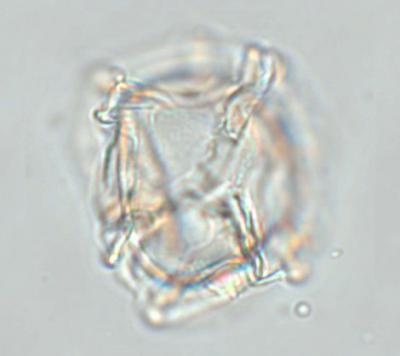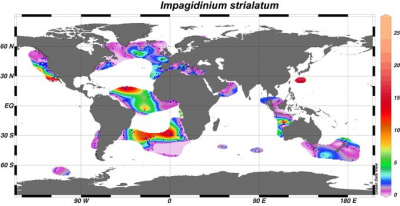Page path:
- Modern Dinocyst Key
- transparent cysts
- Paratabulation reflected by septa
- Septa intermediate height
- Impagidinium strialatum
Impagidinium strialatum
Zonneveld, K.A.F. and Pospelova V. (2015). A determination key for modern dinoflagellate cysts. Palynology 39 (3), 387- 407.

dorsal view
photo: Karin Zonneveld
photo: Karin Zonneveld

cross section
photo: Karin Zonneveld
photo: Karin Zonneveld

ventral view
photo: Karin Zonneveld
photo: Karin Zonneveld
Field Characteristics
Impagidinium strialatum (Wall 1967) Stover et Evitt 1978
Field characteristics:
Small proximochorate cyst of ovoid shape, with a microgranulate wall surface. Tabulation is expressed by relatively high, (weakly) radially striated sutural septa. Tabulation is incomplete especially in the dorsal and sulcal regions. Archeopyle is precingular (type P).
Dimensions: Cyst body: 28 x 33 µm, height of septa: 5 to 10 µm.
Motile affinity: Probably a cyst of Gonyaulax spp.
Stratigraphic range: Lower Miocene to Recent.
Comparison with other species:
Very characteristic for this species is that the septa are high relative to the cyst body and that only part of the tabulation is reflected. The septa are not that smooth as those of I. patulum and can be curved but not so regular as those of I. plicatum. The septa can be striated. Archeopyle is often not visible.
Field characteristics:
Small proximochorate cyst of ovoid shape, with a microgranulate wall surface. Tabulation is expressed by relatively high, (weakly) radially striated sutural septa. Tabulation is incomplete especially in the dorsal and sulcal regions. Archeopyle is precingular (type P).
Dimensions: Cyst body: 28 x 33 µm, height of septa: 5 to 10 µm.
Motile affinity: Probably a cyst of Gonyaulax spp.
Stratigraphic range: Lower Miocene to Recent.
Comparison with other species:
Very characteristic for this species is that the septa are high relative to the cyst body and that only part of the tabulation is reflected. The septa are not that smooth as those of I. patulum and can be curved but not so regular as those of I. plicatum. The septa can be striated. Archeopyle is often not visible.
Geographic Distribution
Geographic distribution based on :
Zonneveld et al., 2013. Atlas of modern dinoflagellate cyst distribution based on 2405 datapoints. Review of Palaeobotany and Palynology, v. 191, 1-197
Zonneveld et al., 2013. Atlas of modern dinoflagellate cyst distribution based on 2405 datapoints. Review of Palaeobotany and Palynology, v. 191, 1-197
Impagidinium strialatum can be considered to be characteristic for open oceanic, full-marine, low productivity environments from temperate to equatorial regions where well ventilated bottom waters exist.

Distribution:
Distribution:
Impagidinium strialatum is observed in sub-polar to equatorial regions bounded by the Arctic sub-tropical front in the north and the Antarctic Polar Front in the south. Exceptions are formed by four sites in the Pacific sector of the Southern Ocean where the species occurs between the polar and sub-tropical fronts. The species is not observed in coastal sites and highest abundances (up to 25%) occurs in the sub-tropical, tropical and equatorial central oceans.
Environmental parameters:
SST: 0 - 29.5°C (winter - summer) except for the four Southern Ocean sites where SST: -1.5°C (winter), SSS: 31.1 - 39.3 (spring - autumn) except for two sites in the Mediterranean where SSS: 27.8 (autumn), [P]: 0.06 - 1.87 μmol/l, [N]: 0.04 - 26.1 μmol/l, chlorophyll-a: 0.05 - 3.1 ml/l except for one Pacific site where chlorophyll-a: 12.9 ml/l, bottom water [O2 ]: 1.8 - 7.1 ml/l.
Abundances > 10% are observed at sites where SST: >5.2 in winter and 18.1 - 28.7°C in summer. I. strialatum is restricted to full marine, oligotrophic to eutrophic environment with low upper water chlorophyll-a concentrations and well ventilated bottom waters.
Comparison with other records:
Apart from regions covered in this Atlas, I. strialatum occurs in the Congo deep-sea fan in samples outside the river plume (Dale et al., 2002). Although it can be present in some Southern Ocean sites where winter temperatures sink below 0°C, it has not been recovered from sites with seasonal ice cover (Radi and de Vernal, 2008; de Vernal and Hillaire-Marcel, 2000). Highest abundances are found in oligotrophic environments. However, sediment trap studies have shown that cyst production of this species increases with nutrient availability and total bioproduction in the upper waters (Zonneveld and Brummer, 2000; Susek et al., 2005; Zonneveld et al., 2010).
Distribution:
Impagidinium strialatum is observed in sub-polar to equatorial regions bounded by the Arctic sub-tropical front in the north and the Antarctic Polar Front in the south. Exceptions are formed by four sites in the Pacific sector of the Southern Ocean where the species occurs between the polar and sub-tropical fronts. The species is not observed in coastal sites and highest abundances (up to 25%) occurs in the sub-tropical, tropical and equatorial central oceans.
Environmental parameters:
SST: 0 - 29.5°C (winter - summer) except for the four Southern Ocean sites where SST: -1.5°C (winter), SSS: 31.1 - 39.3 (spring - autumn) except for two sites in the Mediterranean where SSS: 27.8 (autumn), [P]: 0.06 - 1.87 μmol/l, [N]: 0.04 - 26.1 μmol/l, chlorophyll-a: 0.05 - 3.1 ml/l except for one Pacific site where chlorophyll-a: 12.9 ml/l, bottom water [O2 ]: 1.8 - 7.1 ml/l.
Abundances > 10% are observed at sites where SST: >5.2 in winter and 18.1 - 28.7°C in summer. I. strialatum is restricted to full marine, oligotrophic to eutrophic environment with low upper water chlorophyll-a concentrations and well ventilated bottom waters.
Comparison with other records:
Apart from regions covered in this Atlas, I. strialatum occurs in the Congo deep-sea fan in samples outside the river plume (Dale et al., 2002). Although it can be present in some Southern Ocean sites where winter temperatures sink below 0°C, it has not been recovered from sites with seasonal ice cover (Radi and de Vernal, 2008; de Vernal and Hillaire-Marcel, 2000). Highest abundances are found in oligotrophic environments. However, sediment trap studies have shown that cyst production of this species increases with nutrient availability and total bioproduction in the upper waters (Zonneveld and Brummer, 2000; Susek et al., 2005; Zonneveld et al., 2010).


